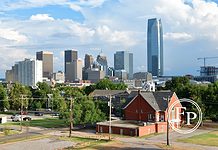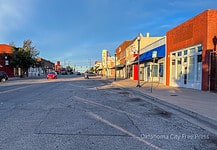Last Updated on March 19, 2023, 7:54 AM | Published: March 19, 2023
OKLAHOMA CITY — The City Council of Oklahoma City voted unanimously Tuesday to approve funding for a first-of-its-kind neighborhood development project at N.E. 26th and Walnut that stands to increase affordable housing supply in the city and provide an example for future neighborhood development plans.
“The Village on Walnut” is the first-ever collaborative project between two of OKC’s Community Housing Development Organizations, or CHDOs (pronounced “chodos”,) with Positively Paseo and Jefferson Park Neighbors Association (JPNA) partnering on the affordably-minded development.
“I call it a miracle,” said Teresa Smith, Senior Planner with the City of OKC’s Community Development Division. “This is absolutely the most ambitious project that any of our CHDOs has ever undertaken.”
Community Housing Development Organizations
Unlike independent affordable housing builders that rely primarily on state and federal tax credits (granted through a complicated and competitive points system) to fund their building developments, CHDOs are non-profit, hyper-local organizations funded through a specially designated allocation of U.S. Department of Housing and Urban Development (HUD) funds.
As part of the city’s funding agreement with HUD, OKC is required to set aside 15% of granted funds each year for CHDO projects aimed at affordable housing and the development and rehabilitation of existing neighborhoods.
These organizations more commonly develop “infill” housing, building affordable and low-income housing units on single available lots in established neighborhoods.

The “Village on Walnut” project, however, will see them constructing a complete community from the ground up on undeveloped land, all designed and built around a large, long-abandoned, historically registered homestead house that will be renovated separately as commercial space.
‘An intentional community‘
Though the official city approval this week was for just the project’s first eight houses – four built by Positively Paseo and four by JPNA – the full proposal is for a complete, brand new community of twenty-two homes.
“The Village on Walnut” is planned as a “pocket neighborhood,” with homes sharing a large outdoor common area connecting houses rather than larger, separated back yards.
“We wanted people to know their neighbors,” said Sheryl Lovelady, Executive Director of the Positively Paseo CHDO. “We wanted an intentional community where people know each other. That’s a safer community, and it’s where people want to live. The national guru of pocket neighborhoods, and the man who wrote the book on them, is Ross Chapin, and he personally gave input on our project.”
After fielding a “design challenge” among twelve architectural firms, Ken Fitzsimmons of OKC-based TASK Design was chosen as the project’s lead architect, with CLS & Associates Landscape Architects chosen to design the outdoor common areas.

When completed, more than half of the homes will be reserved exclusively for buyers at income levels no higher than 80% of the area median income, or AMI. For a couple or a family of three, that would mean incomes well under $60,000 per year will qualify, as well as being eligible for $15,000 in down payment assistance.
According to Smith, the goal is to help lift prospective home buyers out of the rental cycle to combat the negative consequences of rising community values and skyrocketing rent prices.
“There’s no way to gentrify homeownership,” she said. “This is not like an area gets kind of advanced, and then the rents go up, and then people have to move because it’s so expensive. If you own your home there, you do not have to move. No one can force you to sell your home.”
First-ever partnership
This project sees two CHDOs, Positively Paseo and JPNA, partnering for the first time since the CHDO program was introduced to OKC in 1993.
In that time, Positively Paseo has helped to rehabilitate and develop the Paseo District from its “blighted” state of the late-1980s, as well as the Capitol Hill and Capitol View areas more recently.
Jefferson Park Neighbors Association was originally created to restore the Jefferson Park neighborhood before expanding into the successful Classen29 project at NW 29th and Classen.
But even with decades of localized neighborhood success, no two CHDOs have ever partnered on a single project in OKC.
“Pam Bigham at Jefferson Park actually ran across the property for sale,” Lovelady said. “The owners were going to sell it to a guy that was going to level the house and put mini storage on the site.”
Working together, they were able to pool enough money to buy the full, multi-lot property – a one-time homestead built and settled in 1911 and possibly abandoned since the 50s, – successfully register the home as an historical structure, and submit the neighborhood plan for approval.
“It’s such a wonderful thing to partner with Jefferson Park, because neither of us could have done this on our own,” Lovelady said. “Teresa and other city planners have been so excited and we’re just so appreciative that they saw the same vision we did and not just another storage facility. It really is kind of a miracle project.”
Brett Fieldcamp has been covering arts, entertainment, news, housing, and culture in Oklahoma for nearly 15 years, writing for several local and state publications. He’s also a musician and songwriter and holds a certification as Specialist of Spirits from The Society of Wine Educators.










